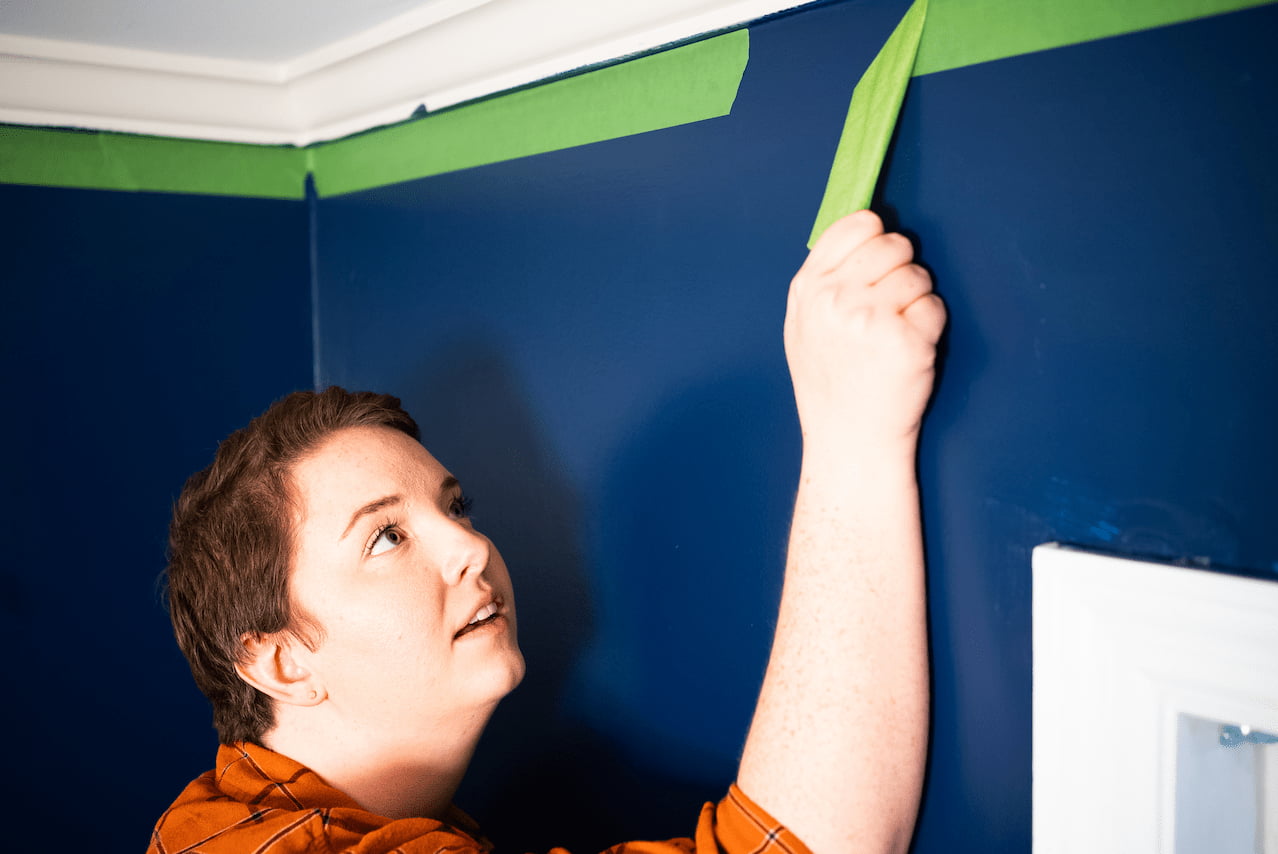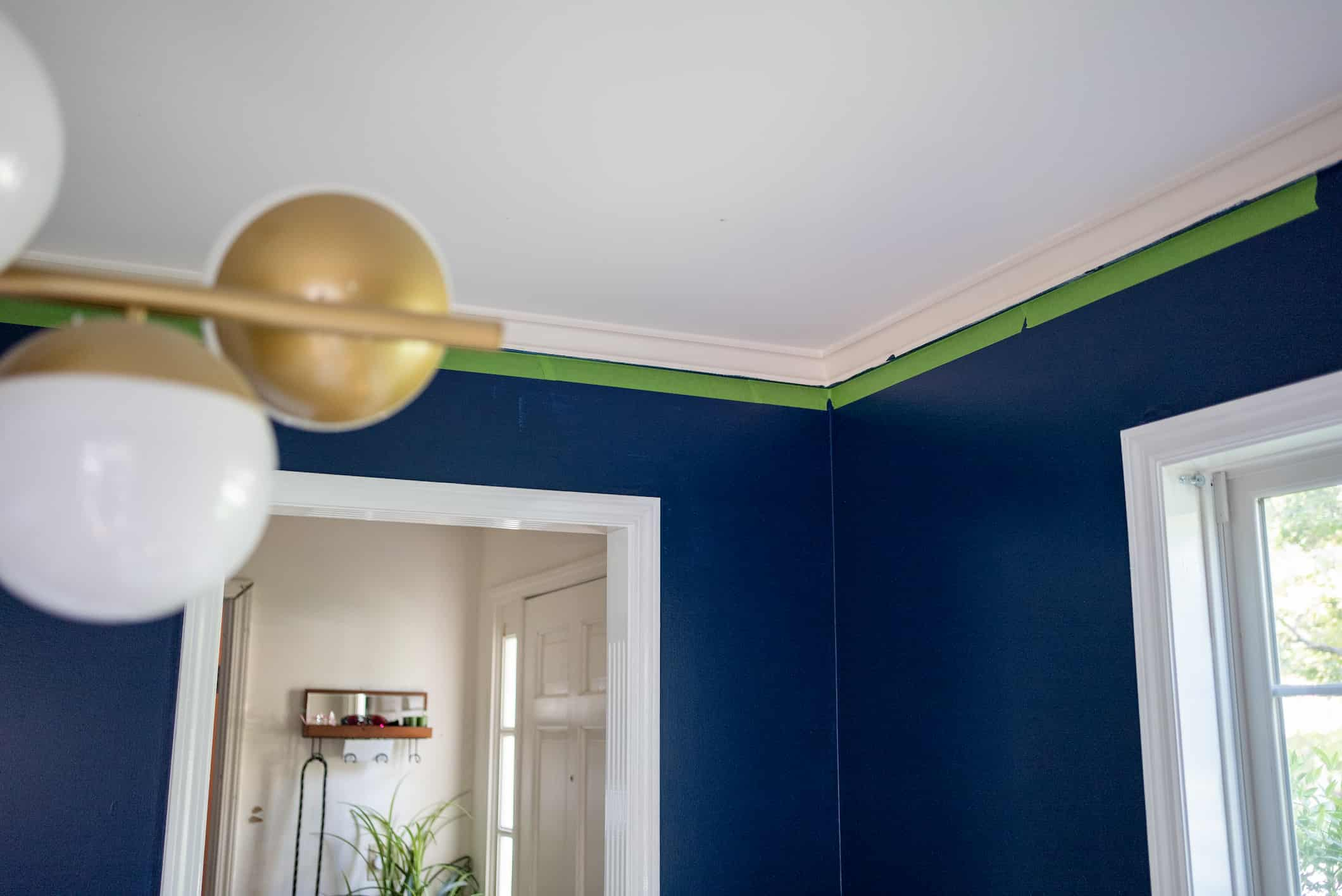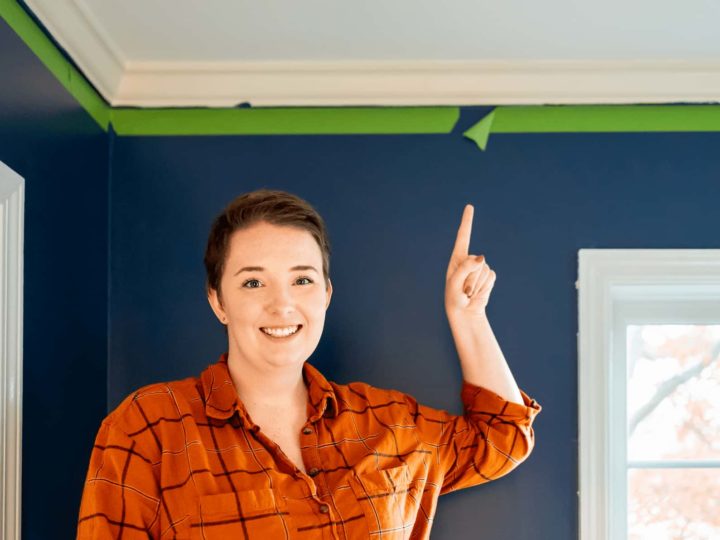You’ve used a quality painter’s tape to meticulously prep your walls, painted, and…life happened. Several hours, days, weeks, or even months have passed, and you’re scared to remove it. Now you’re left wondering: can painter’s tape be left on too long? Did you just ruin your paint project? All the focus in painting is on prep – but when are you supposed to take painter’s tape off?
Most brands recommend removing painter’s tape within 14 days of application, but it’s best to remove it as soon as the paint is dry to the touch (about an hour after painting). Waiting too long to remove painter’s tape will damage the wall and potentially leave behind a sticky residue.
I’ve definitely left painter’s tape on too long in the past, but have learned a few tips and tricks along the way that I’d love to share with you. In this post, I’ll be covering whether or not painter’s tape can be left on too long, how long each brand and type of painter’s tape should be left on, why painter’s tape sometimes pulls off paint, how to remove painter’s tape that’s been left on too long from walls, concrete, carpet, and solid surfaces, which painter’s tape you should use, and when painter’s tape isn’t the best option.
Table of Contents
- Can painter’s tape be left on too long?
- How long should painter’s tape be left on?
- Why is my painter’s tape pulling off paint?
- How To Remove Painter’s Tape That’s Been Left On Too Long
- Which Painter’s Tape Should You Use?
- When Painter’s Tape Isn’t The Best Option
Can painter’s tape be left on too long?
Tape can absolutely be left on too long – and it happens to the best of us. I’ve ruined walls, concrete floors (more on that later), and a bunch of other things by leaving the tape on too long. It’s easy to do!
If you’ve left your tape on longer than you meant to, don’t worry – you can definitely still take it off with minimal damage. I started painting our dining over a year and a half ago, and unfortunately left some tape up the whole time.
To make matters worse, it’s FrogTape, which only has a working removal time of 21 Days – AND it’s intended for trim, baseboards, carpet, and glass…not freshly painted walls. I’m only about 365+ days late. It’ll be fine, right?
PS: The pandemic happened during this time, and I was raising two toddlers, so don’t judge too hard. Sometimes things that you plan for just don’t happen!

Well…it was actually completely okay – the tape was removed with no problem.
With that being said, I went with a semi-gloss in this room because my toddlers often like to have food fights, so I may not have been so lucky if I had gone with a more flat sheen.
I originally put the tape up to give the crown molding a nice, crisp coat of white, but probably not for another few years or so (ha!).
How long should painter’s tape be left on?
The length of time painter’s tape is rated for removal varies from brand to brand, but the general consensus is to remove interior painter’s tape within 14 days of application. That being said, recommended times vary between 5 days and 60 days, so I’ve compiled all of the major brand’s (Scotch and FrogTape) styles and their removal guidelines below to save you some time:
| Brand and Tape Name | Tape Color | Intended Surfaces | Removal Time |
|---|---|---|---|
| Scotch Delicate Surface Painter’s Tape 2080 | Pink | Freshly painted walls, wood floors, wallpaper, veneers, cabinets | 60 Days |
| ScotchBlue Ultra Sharp Lines Painter’s Tape | Blue | Textured walls, trim, baseboards, tile, glass | 28 Days |
| ScotchBlue Sharp Lines Painter’s tape 2093 | Blue | Smooth or lightly textured walls, trim, baseboards, tile, glass | 21 Days |
| Scotch Exterior Surface Painter’s Tape 2097 | Yellow | Exterior surfaces, semi-smooth metal, vinyl, painted wood, glass | 10 Days |
| Scotch Rough Surface Painter’s Tape 2060 | Green | Concrete, brick, stucco, rough wood | 5 Days |
| ScotchBlue Original Painter’s Tape | Blue | Smooth or lightly textured walls, trim, baseboard, tile, glass | 14 Days |
| FrogTape Multi-Surface Painter’s Tape with PaintBlock | Green | Trim, baseboards, carpet, glass | 21 Days |
| FrogTape Delicate Surface Painter’s Tape with PaintBlock | Cream | Finished wood, fresh paint, wallpaper, veneer, laminate, vinyl, primed drywall | 60 Days |
Why is my painter’s tape pulling off paint?
If you’re experiencing paint being pulled off by your painter’s tape, it’s likely caused by one of three things:
- The tape was left on too long
- The adhesive level of the tape was too strong
- You’re pulling the tape off too quickly, or at the wrong angle
While the original blue tape is what most people think of when you mention painter’s tape, it’s not always the right product for the job. If you refer to the chart above, you’ll be able to easily find the right tape for your particular application. – usually pink/white for delicate, blue for regular, and yellow/green for heavy-duty jobs.
If you know that you’ve used the right tape and are still experiencing paint peeling, slow down. It’s amazing how much more cleanly tape will remove if taken off slowly and at a 45-degree angle.
If you’ve chosen the right tape, AND you’re moving slowly, consider using a very sharp knife or razor to gently score the tape – that can help it release more easily and help avoid the dreaded peeling paint.
How To Remove Painter’s Tape That’s Been Left On Too Long
Walls
If you’ve left painter’s tape on your walls for too long, try using a hairdryer to help remove it. Work slowly, peeling a few inches at a time. If you have some leftover residue, a putty knife can work wonders. I really love this set (affiliate link) – they’re just sharp enough to help scrape efficiently without gouging the paint!
If the residue is really stubborn or sticky, sanding is always an option – we’ve used my trusty Ryobi Random Orbit Sander (affiliate link) for larger sections and my Corner Cat Finish Sander (affiliate link) for hard-to-reach areas in the past. It’s loud, messy, dusty, and time-consuming, but sometimes it’s the only way to get sticky residue off.
PS: If you’re looking for other tool recommendations, check out these posts:
- The 10 Beginner Tools EVERY DIYer Should Own
- 39 Great Gift Ideas for All DIY Skill Levels (Great for Christmas gift ideas!)
Concrete
In our very first apartment, we had to spend pretty much everything we had on the deposit and didn’t have any furniture for a while. But painter’s tape was cheap, and helped me visualize how the furniture we would eventually buy would utilize the space. So, I taped off different areas on our concrete floor and left them there for a while until we saved up enough.
Unfortunately, painter’s tape and concrete DO NOT MIX. PSA for anyone out there – never put painter’s tape on concrete floors. When I went to remove it, the tape had chemically bonded with the floor and peeled up much of the seal along with it. I tried just about everything to fix it, but you could always see the lines where the tape had been.
If you’re finding yourself in the same situation, I’m so sorry. What I found to help the best was a SUPER strong chemical cleaner to remove the residue, and then a concrete wax or sealant that matches the sheen already on your floors. They will probably never look the same, but it’ll help.
Wood Flooring
Depending on your flooring, this is probably a pretty easy clean-up – just wipe some olive oil on the leftover adhesive and scrub with a rag or dull putty knife. I love these plastic ones (affiliate link) for applications like this. They’ve never scratched any surface I’m working on, and are super inexpensive.
I’ve heard people have successfully used Goo-Gone (affiliate link) for applications like this too, but I would definitely test in an inconspicuous area before lathering it on. You’ll also only want to use it if your wood is well sealed.
Carpet
We haven’t had carpet in our homes for a long time (young kids + pets), but all the same rules for removing any kind of sticky mess apply to removing leftover adhesive from painter’s tape. Generally, you want to freeze the adhesive so it’s hard, and then scrape it off with a knife.
Solid Surfaces (Countertops, Glass, Metal, Etc.)
Solid surfaces are actually one of the easiest places to remove leftover residue – you’ll just need a super sharp razor and a lot of patience. I bought this set (affiliate link) earlier this year and just take out a brand new razor each time I need to clean something. They just live in my cleaning kit now!
My best advice for using a razor to clean up painter’s tape residue (or any other residue for that matter) is to work at a shallow angle, use short strokes, and be really careful. Patience is your friend.

Which Painter’s Tape Should You Use?
If you’re just working with regular drywall and interior paint (that’s had a chance to cure for more than 7 days), blue painter’s tape (affiliate link) is best. Painters and homeowners (including me!) have been using this stuff for a LONG time, and it’s a great product.
The green painter’s tape (affiliate link) is best left for rough and uneven surfaces – though I’ve definitely used it in the past for drywall and it’s cleaned up just fine. I would remove this tape as quickly as possible though, since you’re kind of playing with fire if it’s used for an unintended purpose. (I get it…sometimes it’s all you have on hand!)
There’s also a great product that’s usually pink or cream (affiliate link) that you can use on delicate surfaces like freshly painted walls.
Whatever color of painter’s tape you choose, you’ll want to read the packaging – specifically on how long it’s rated to stay in place without causing damage, and which surfaces it’s intended for.
If you’re like me and have probably already thrown away the packaging, compare a few of your tapes by sticking them to your hand to judge the tackiness, and then opt for the least tacky. Better to touch up some bleeding paint than have to do drywall repair!
When Painter’s Tape Isn’t The Best Option
If you’re constantly finding yourself with tape that’s been left on too long, learning to use a sash brush instead of painter’s tape can be a HUGE asset. No tape means less prep, no damage to your walls, and easier cleanup.
I made the switch from painter’s tape to a sash brush a few years ago, and while my lines are not always perfectly straight, it sure beats taping, painting, removing the tape, etc. This is my current favorite (affiliate link) – it has a little hook on the side so you can rest it on your paint can since it’s too short to lay across the top.
With that being said, unless you’re a professional painter, it’s easy to lose control with just a brush. If you’re painting something high contrast (like I did in my dining room), painter’s tape is still the way to go.


Cathy
Sunday 22nd of October 2023
Left painters tape too long on new tile grout when repainted adjoining wall. When I took tape off left white backing of the tape. Any suggestions to remove it from the grout?